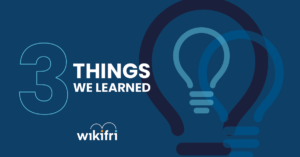
|
Hello Friends! Team Wikifri is gearing up to make waves at Insurtech Connect Vegas next week. We can’t wait to dive deep into cutting-edge discussions about the future of the insurance industry, and we’d love to see you there. Now, onto some pressing matters that have lit up the insurance headlines. Layoffs are rattling the industry, intensifying the perennial struggle with public perception. Meanwhile, Q3 earnings are coming in hot, delivering a mixed bag of victories, challenges, and strategic recalibrations. And speaking of strategy, this week has been a masterclass in navigating growth, innovation, and leadership changes. Buckle up, because the industry is at a thrilling crossroads, and there’s a lot to unpack: |
[1] |
Layoffs and the Perception QuagmireThis week saw the dam break on workforce reductions across the insurance sector. With headlines glaring, like Pekin instituting layoffs, Germania Insurance slicing 7% of its team, Liberty Mutual parting ways with nearly 2% of its U.S. workforce across many functional areas, and Hippo letting go a staggering 20%, it’s not just water-cooler talk—it’s headline news. Aon joined late in the week with results and ‘workforce restructuring’ details. These companies point fingers at rising costs, weather-related catastrophes, and, well, the need to ‘focus.’ Here’s where it gets gnarly. The insurance industry carries the heavy burden of being one of the least trusted sectors by the public. When layoffs like these are bundled with rising premiums, claims denials, and complicated policy language, the skepticism escalates. Layoffs are tough, but how the industry handles them could be the difference between a public perception of necessary evil and an unforgiving behemoth. Now, more than ever, insurers need to lean into clear, honest communication and customer-centric services. Let’s not forget, perception is nine-tenths of the game. |
[2] |
Scoreboard Update : Q3 2023 ResultsThe Q3 scoreboard is all lit up with wins, losses, and everything in between. Munich Re is like that star athlete who keeps breaking their own records. The German giant pushed its annual profit forecast. But let’s keep it real; Aon says global insured losses from natural disasters are still sky-high. So, the industry isn’t exactly singing in the rain. Chubb Ltd. is on a winning streak, reporting a juicy Q3 net income increase to $2.04 billion. CEO Evan Greenberg is particularly jazzed about strong P&C underwriting income and rate hikes in both domestic and international markets. Everest Group, it’s a comeback story worthy of a sports movie. Q3 net income rocketed to $678 million, flipping the script from a $319 million loss last year. CEO Juan Andrade is steering Everest like a pro skier leaning into the hard turns of the reinsurance market. Oh, and they’ve got a new U.S. wholesale division in the works. Momentum? RLI Corp, meanwhile, hit some turbulence. A decline in net income to $13.5 million might have some raising an eyebrow. Despite heavy losses from wildfires in Hawaii, they’re holding the fort with an 11% rise in gross premiums. Kemper Corp is also stuck in a hard place. They’re projecting a net loss up to $150 million for Q3, almost doubling last year’s losses. Blame it on prior-year reserve development and tricky claims in Florida. But hey, they’ve got liquidity of $800 million, and they’re shaking things up, like exiting preferred home and auto lines. W.R. Berkley is popping champagne with a 45.7% net income increase. CEO Rob Berkley is talking up their robust underwriting results, but he’s keeping an eye on shifting medical cost trends in workers’ comp. Brown & Brown had a decent run, netting $175.9 million in Q3. CEO J. Powell Brown mentions that while rates are stable, capacity is strained, especially in catastrophe-prone states. Cincinnati Financial is improving with a net loss decrease to $99 million. CEO Steve Johnston is bullish on their robust performance and future prospects, particularly in pricing and risk management. They’re expanding their reach, planning to launch in Nevada and adding new agency locations. |
[3] |
Strategic Chess Moves: Navigating Growth, Innovation, and Leadership ChangesThis week, we’re seeing industry players doubling down on strategic growth, innovation, and diversification. Gallagher is playing the acquisition game, dropping $904 million in cash to snag Cadence Insurance. They’re the second-largest bank-affiliated insurance broker in the U.S., and this buy helps them pivot while Cadence can refocus on banking. It’s like a strategic chess move where both players win. It also follows the trend previously reviewed with Truist’s plans. White Mountains Insurance Group has kicked open the door to new possibilities by launching WM Partners. This freshly-minted division, headed by veteran John J. Daly, is laser-focused on injecting institutional capital into family, founder, and entrepreneur-owned businesses. Their endgame? Secure majority stakes in companies with an EBITDA ranging from $10 to $50 million. Boost Insurance is taking a digital-first approach with Boost Re, their latest risk transfer platform. Designed as a turnkey solution for MGAs and insurtech firms, it’s positioning Boost as an industry innovator. Speaking of leadership, Greenlight Re’s boardroom is getting a facelift, as they’re on the hunt for a new CEO to steer the ship. Meanwhile, agency software behemoth Applied announced the launch of Tarmika Insured to offer embedded commercial lines quoting, promising a streamlined experience for agencies and consumers alike. These moves spotlight an industry at the crossroads of risk, technology, and strategic evolution, and you better believe they’re making waves. |
|
Join us as we continue to explore the headlines and news shaping the insurance sector, and stay tuned for more insights on the unfolding narrative of our industry! Stay productive, stay safe and stay in touch! |
